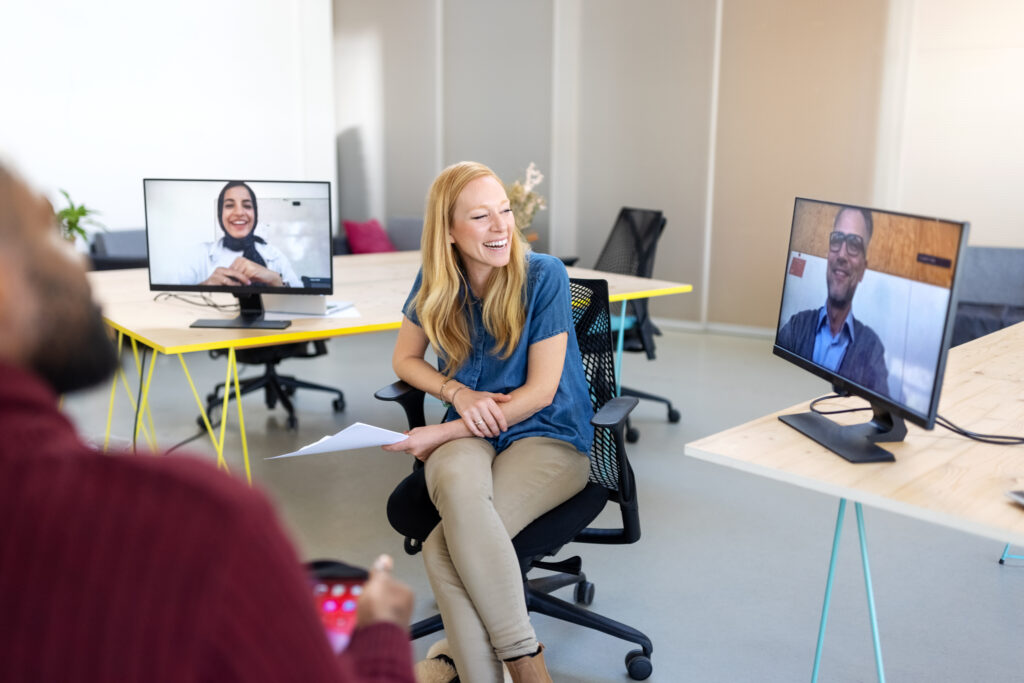As more companies begin embracing the hybrid work model, where some employees return to the office while others remain remote, new patterns in the workplace have also started to emerge. Read on to hear from experts across a wide range of industries on what specific workplace trends you can expect from the future of work.
More movement away from big cities
With more opportunities to work from home and fewer expectations for employees to stay on-site, workers will be more likely to live farther away from their physical offices. Some experts have already observed such shifts taking place.

“I recently analyzed a huge survey performed on the biggest U.S. cities, including San Francisco, New York, and Chicago,” says Nadia Harris, founder of remoteworkadvocate.com. “It showed that within the past year, many people have left those cities, and they have moved to the suburbs.”
With the easing of restrictions on international travel, remote work advocates like Iwo Szapar, co-founder of Remote-how, predict that working from around the globe may also emerge as a popular option for remote employees.
“People will go to places like Colombia, Costa Rica, or Vietnam, and they will be working from there,” says Iwo, “but not as digital nomads, which was the thing for years. There will be a new trend emerging that I like to call ‘slowmad,’ like slowly moving to a different place.”
Transformation of office spaces
There are a lot of upcoming changes expected for the architecture of traditional offices, with some groups choosing to scale back spaces while others are completely reorganizing their layouts for employees.
“I think you’re going to see more and more employers trying to cram in the people that are in the office,” shares Cynthia Watson, CEO of remote consulting firm Virtira. “We saw a lot of what’s called ‘densification’ in the workplace prior to the pandemic. We saw cubicles going away, we saw offices going away, we saw [hot desks].”
Hot desking, a practice where multiple workers use the same space at different times, may continue for some companies moving forward. For others, the purpose of the physical office may change completely.
“Some companies are changing their workplaces to be remote first and using their office space as a meeting space, almost like a coworking space, for their employers or employees to come and meet whenever they need to,” says Brie Reynolds, the career development manager at FlexJobs.
Increased accessibility for employees
Now that leaders and managers have more experience running remote teams, the hybrid workplace will likely offer more flexibility for employees regarding where or when they can work.
“Two years ago, the number one requested or desired benefit from employees was to be able to work from home part of the time,” says Kevin Eikenberry, Chief Potential Officer of The Kevin Eikenberry Group. “That is now going to be an expectation moving forward. I don’t think you really have a choice if you want to maintain your talent and attract future talent.”
Regardless of where their employees are based, companies will also start prioritizing accessibility in their operating systems to ensure all employees can work at full capacity, no matter where they are. Jana Piske, remote team building coach and founder of Fairlinked, applies this mindset when leading her own teams.
“Whenever I’m thinking of hybrid work, it is super important to think about how it could work in a 100% remote team because the tools have to be accessible,” says Jana.
Larger talent pools for employers
Companies will start to see more diverse candidates for remote or hybrid job openings who benefit from the freedom offered by working outside of a typical office setting or schedule.
“With more flexibility, [companies] can get incredible people that are out there and that want to work for them,” says Chris Dyer, remote work expert and CEO of PeopleG2. “I can get this great person who’s actually better than anyone else I’ve ever had in that position, and I never talked to them. You’re able to access talent pools that you never thought of before.”
For people with special circumstances, remote work can also accommodate them in a way that wasn’t possible with in-person work schedules.
“We’ve worked with people who, for a variety of reasons, whether it’s a physical disability, some kind of health issue, or they’re acting as a caregiver for someone else, they cannot commit to an in-office Monday through Friday, nine-to-five job,” says Brie. “But, they would be an incredibly valuable employee to a company that’s willing to let them work remotely.”
Emphasis on team building
With the workforce growing divided between in-person employees and remote workers, leaders and managers must ensure their team members feel seen and included by actively checking in and keeping them in the loop.
“I’m seeing a lot of people really struggling with feeling like their efforts are going unseen, unacknowledged, and unrewarded,” explains Liane Davey, bestselling author of The Good Fight and co-founder of 3COze Inc. “When we’re working remotely, there’s this challenge that our work takes physical, emotional, and cognitive labor that isn’t necessarily obvious in the output.”
With remote communications in particular, there’s a lot that can be lost in translation. There are body language cues or tone of voice for people to pick up on from an email, so it’s important to make sure you’re coming across to your employees the right way and that your workers feel heard. Chris has one particular method he likes to use for resolving conflicts in the workplace.
“We teach all of our leaders to use this technique called ‘Three Plus,’” shares Chris. “You need to repeat [what someone says to you] back three times to make sure that you got it right. When people get upset, they might have trouble articulating what’s actually wrong. So when leaders repeat back what they think they’ve heard, they can suddenly drill down into what the real issue is.”
Above all, the first step to creating a welcoming and supportive hybrid office environment is to be deliberate about your goals.
“Cultures of inclusion and belonging don’t tend to happen by accident,” says Dr. Tiffany Jana, CEO and founder of TMI Consulting. “You either have an intentional set of programs and imperatives, or you have intentionally inclusive people that know how to make people feel like they are embraced.”
Continuing “remote first” communications

For a hybrid office, you might expect hybrid meetings to be the norm. However, remote meetings may continue to remain the best option for maintaining seamless communications among employees, according to leaders like Kevin.
“For a truly collaborative meeting, where you want everyone’s input and best thinking, then I would say put everybody in a virtual meeting,” recommends Kevin. “Don’t put half the people in the room together and the other half not, because it’s just not going to work nearly as well.”
Why continue remote-first meetings for a hybrid workforce? Not only do they put all employees on a level playing field as they each call in from their own space and device, but there may also be some psychological reasoning behind the decision.
“Subconsciously, what happens is the person who is working at home might actually see a crowd [of in-office workers sharing one screen] as people ganging up on that person,” says Bhagyashree Pancholy, owner of All Remotely. “So they may not open up, they may not talk, or they may not be comfortable speaking to a large section of people listening to them together.”
“Physical intimidation tactics in the workplace will be lessened by the equity of showing up on video instead of shoulder to shoulder at the board table,” says Danielle Taylor, Deputy CEO of TMI Consulting. “In video meetings, team members are eye to eye and arranged according to when they joined a call, not by positions of power.”
According to experts like Natalia Walters, senior consultant at U.K. innovation company Fluxx, there are also benefits offered by the asynchronous nature of virtual meetings that companies shouldn’t overlook.
“Asynchronous collaboration unlocks flexibility because it means that people aren’t expected to be online at the same time and respond instantly,” explains Natalia. “It also plays to the strengths of different personality types. Introverts who may want to take a bit more time before contributing to an idea are able to think on their own time and then add their thoughts later.”
Final thoughts
As you’ve seen, big changes are coming to the future of work. Many companies are now entering a new landscape unlike anything they’ve experienced before. With all of these new workplace trends, it’s important to be prepared to adapt to whatever new situations a hybrid office may introduce.
“We’re headed into a large period of experimentation when it comes to workforce and workplace strategy to figure out what’s going to work right for each organization,” says Sacha Connor, founder and CEO of Virtual Work Insider. “No one’s going to get it right off the bat. They just need to be able to continue adjusting as they go.”
What workplace trends do you predict for 2021? Share your thoughts by creating a Prezi video and tag it with #hybridwork for a chance to be featured. To hear more from experts, you can also look to our Video Gallery to see what else the future of work may hold.
